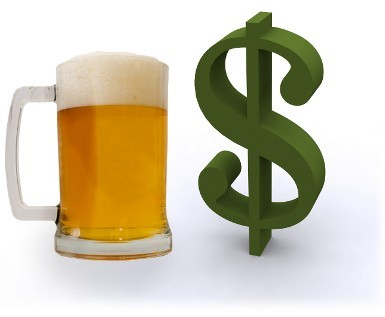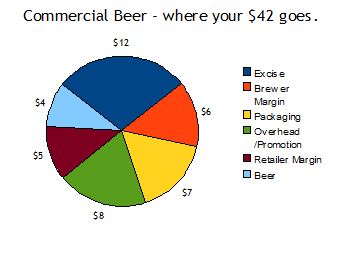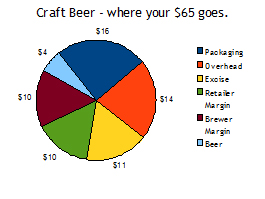
The economics of microbrewing
There is an assumption that it must be profitable to make beer when you’re selling it for upwards of $65 a case. How can it be that craft beer is often twice the price of mainstream beer and yet we hear so often that brewers are making no money? Yet, evidenced by the number of breweries that come and rapidly go a short time later, the contrary is true. Do a straw poll of even our most well-known small craft beer producers as well as some of the newcomers and you will find that money is almost always in short supply, and businesses often marginal at best. The answer to this conundrum is both simple and complex, but it really all comes down to volume.
Lion Nathan and CUB produce or import about 90% of the beer that we drink, which equates to roughly 200 million cases of beer a year. That’s a great deal of beer, produced in super-factories fermenting 300,000L of beer at a time, doing this 12 times a day and bottling at 50,000 bottles per hour 24 hours a day.
Think how cheap your boxes and bottles are going to be if you ring up a manufacturer and say that you want to buy a couple of million boxes a week or a few million bottles every day? That’s the kind of volume that factories are made of. As a result, a case of macro lager will cost you $42 odd bucks at a bottle, setting a pretty low benchmark – even though the brewery is still making a few dollars on every case.
Aside from the mighty Little Creatures and Matilda Bay with their big brewery tie-ins, consider your humble craft brewer who will deem himself fortunate to sell a few thousand cases a year, with 10,000 cases being a generous average (surprised?). They will find that rather than paying 30c for their boxes, they are paying 75c; 28c for bottles compared to 16c and $1100 a tonne for their malt rather than the $600 the big boys will squeeze out of the maltsters (and that’s just for the big brewers’ all-malt brews – a high cane sugar content carries an even greater discount) . Even on the bottles alone, that represents an added 5 per cent better profit margin to a large brewer on every bottle of beer sold.
The cost of materials and scale of operation therefore make a huge difference to the cost make-up of the two beer types, take a look at this graphically and the differences between the small brewer and the macro brewer become startlingly apparent.
Clearly when you are buying beer, you are actually really paying the government a lot of tax, buying a lot of packaging, paying for the cost of production of the beer and actually spending not a lot on the beer itself, less than $5 probably.
What is also apparent, is that selling 10,000 cases may theoretically net you $100,000 a year, but out of that, there’s tax, reinvestment in the business, loans to pay-off and any number of risks that running a small business entails. Setting up a brewery is an expensive business running into hundreds of thousands or millions of dollars. The question is, is the risk reward scenario there?
You can also see why the craft brewers advocate for reduced excise with the Government taking a huge chunk of the cost of the beer you buy. Small winemakers don’t pay this tax which would go quite a way to explaining why they often go to work in a fancy four-wheel drive and many of your brewery owners take their bicycle.
Not that they’re bitter though, they leave such things to the hops.






